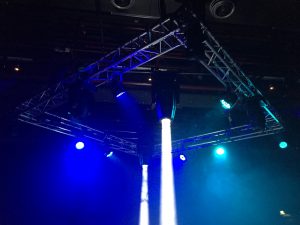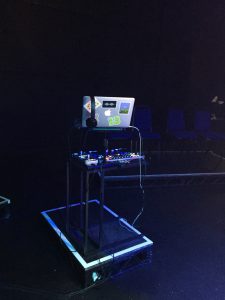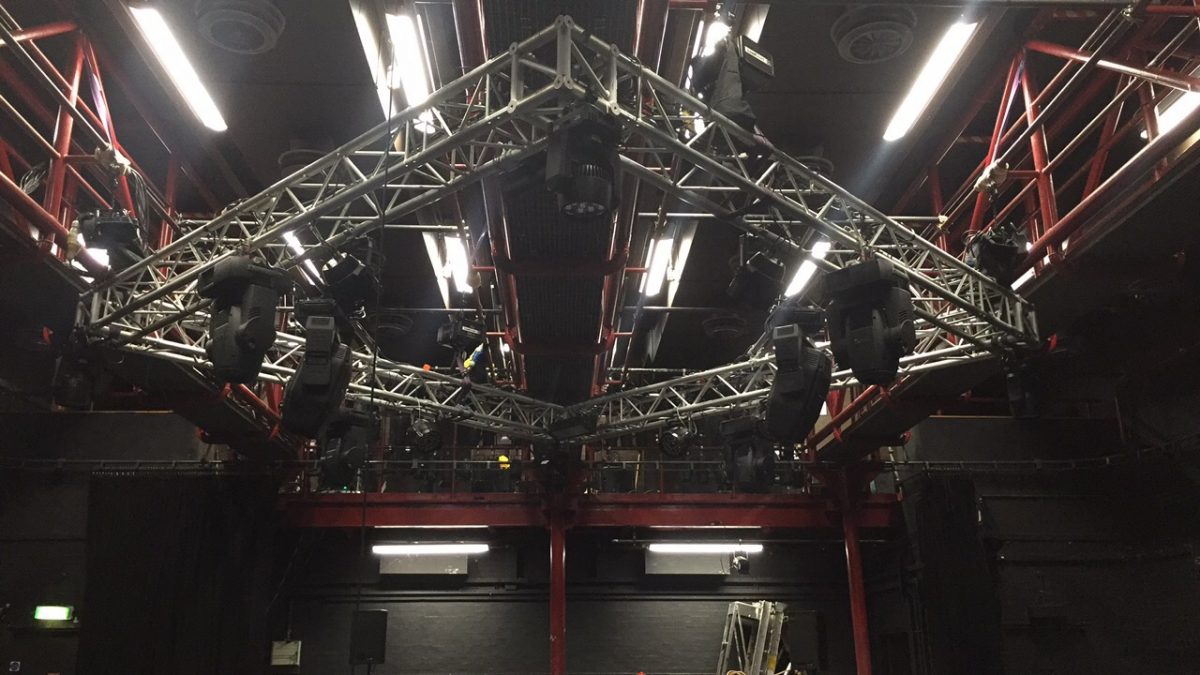The arrival of the CPP2 show brought with it a new lighting designer and two new crew members in the form of Poppy and James. It also brought Vectorworks plans and an in-the-round design, two things that I was excited to get to work with. The venue had been mostly stripped back to its bones following CPP3, with the seating bank being shoved back to the wall and all overhead LX fixtures shoved back on their meat racks leaving us with a blank canvas to work from. The second year CPP students had their piece devised with them by a director, who wanted to create a club vibe for their hour-long dance piece – their field trip to Sub Club acting as a catalyst for the piece’s development. In light of this Stephen, our LD, wanted a truss square to be flown in the centre of the room, something that Fee, Daryl and I set around assembling as our first priority.

I was given the job of putting in the points from the catwalks, using a strop choked around the poles with a shackle on the end, and gaffa tapping burlap to the LX rust bars to minimise the strain on the point. What concerned me, however, was the fact that we had started to return to our old CPP3 habits very quickly, the truss changing size because it didn’t look right in the space, meaning every point was changed and new load calculations had to be done at the last minute. Yes, I understand the need to be able to adapt when something doesn’t look right, but understanding the hassle we had had in the weeks prior with last minute changes to plans, to see it happening again so early on in this new process raised red flags to me, and left me wondering whether anyone else had learned from our previous mistakes. However, by the end of the morning session the truss was in the air, and Fee and I setting about looming motor control so I could plug up on the catwalks in a tidy fashion, so as to facilitate a clean and quick strike.
We then moved onto assisting LX, hanging the eight overhead generics before assisting in plugging up the truss structure. Once this was done and flying it became apparent how lacking in things to do we had become, and how this show was actually a lot smaller than it had appeared from the outset. Then the director arrived. Will had shown himself in previous sharings to be very fond of ‘feeling things in the space’ before making decisions, and this showed itself, notably, when it came to the issue of seating. He wanted steel deck stacked bleacher style, a concept which – as Steve explained to him – would defy the laws of physics to achieve with the resources we had. It was interesting to watch a lecturer have this conversation, as I learnt a lot about how I should endeavour to deal with creatives when their ideas are just not feasible, always being able to present them with an option close to what they want but with the added practicality of actually being achievable. With a plan in mind, Fee pulled deck legs from the store whilst myself and some other team members navigated the pit lift – which had decided it just didn’t want to work for us – to bring deck to the venue. Upon our installation of the first legs, however, it became apparent that someone had made a very big mistake. For some reason, the 600mm legs in the dock had become mixed with a selection of 530mm legs – 75 of them to be accurate – throwing off our deck by enough that, if someone were to sit on it, there was a good chance they’d roll head first into the red pillars behind. This reaffirmed for me the importance of being thorough in checking when pulling kit – and also when returning it – as the appropriate labelling and categorisation had clearly not been in place when these were made. It’s little annoyances like these that can really slow down a process, and cause a team to get annoyed with each other.

When Your DJ Table is 200mm Too Short
As the deck was sitting on top of each other, we had to work out a way of preventing it sliding off and falling to the floor. I had a rough idea of creating plates for the sides of the lower level to wedge the top layer on, but I gave this job to Callum and Adlai to complete, as Callum had come up with the concept of creating blocks with a drilled 60mm hole to act as pucks that could be screwed down and prevent slipping. Whilst they prepared these, I set about returning all of our CPP3 kit and giving the venue a general tidy and clean, with the idea that if we kept our workspace clean as we went, pre show work would be a lot easier to manage and we would all have a safer and happier environment to work in. With the pucks created and the venue tidy, that was it – CPP2 was up. There were no in show cues for the Stage team so our call times stretched to the strike day with nothing in between. Having these days free was very beneficial, and allowed me to plow through some reading and course work. However, I would have preferred if the promised rig plan meetings that I was supposed to have with my HOD had not been cancelled last minute, as I was fearful that we would end up in the same situation in the eventual CPP 1/4 shows as we did with the CPP3s – albeit over a shorter turnaround time.
So in conclusion, CPP2 was less thrilling than we had anticipated it may have been. It proved to be an exercise in how to cope with slow shows, finding ways of entertaining ourselves by doing the little jobs after blitzing through a rig with professional attitudes and work speeds. Following on from this, I would have liked to have used this time to forward plan for the shows coming up, as we were aware how tricky they would be with the one session turnaround times that we had. However, it was nice to get to work in the round with truss, as it reminded me of all the quirks that motors bring to a performance – shadowy thoughts I thought I’d left behind in the EFT.
SaveSave

